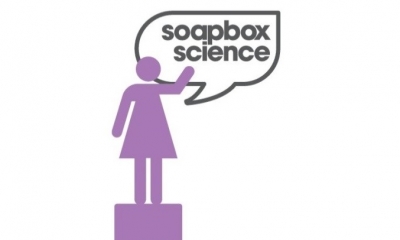University of Oxford
11a Mansfield Rd
OX1 3SZ
UK
Building on the success of the 2016 Soapbox Science event, the 2017 event takes on a new and exciting element! Who is a scientist and who is an artist? Can the work someone in a lab coat is doing relate to a painting, or a dancer, or be understood through music? Artists and scientists have increasingly started to make use of the benefits of working together and Soapbox Science will be helping to facilitate interdisciplinary collaboration in 2017.
The new Soapbox Science project aims to bring science to arts fans and art to scientists. By fostering great collaboration and challenging the artists and scientists to work together, Soapbox Science will bring difficult science concepts to the public in exciting, innovative and engaging ways.
The new Soapbox Science and Art 2017 event will capitalize on Soapbox Science’s current strengths to widen the audiences exposed to science carried out by women and will facilitate communication and collaboration between the arts and science communities.
On Saturday 1st July at Oxford Festival of the Arts, the first of the year’s Soapbox Art & Science events will see scientists and artists paired together to explore a range of scientific topics in exciting new ways.
Soapbox Science’s Aims
- To bring the opportunity to meet and interact with scientists to unexpected places
- To increase the visibility of women in science
- To promote collaboration between art and science
- To find new and innovative ways to present science and art to the public.
The Selected Scientists, Their Proposed Topics and Their Artists:
- Prof Sonia Contera, Associate Professor, Physics Department/University of Oxford. “Nanotechnology and the Future of Biology: the converging technologies that will shape the future of Medicine.” Sonia will be teaming with Ellen McAleavey, an art student at Oxford Brookes University.
- Dr Ayoe Buus Hansen, MetOffice. “Dispersing knowledge – how I model atmospheric dispersion” Her artist will be Kate Davis, art student at Oxford Brookes University. Read more about Kate and Alyoe here
- Dr Helen Barron, Junior Research Fellow, University of Oxford. “Your story: how does your brain remember?” Will be working with Natasha Zielazinski, a composer.
- Dr Jennifer Pike, Reader in Palaeoclimate and Climate Systems, Cardiff University. “Tiny fossils answering big questions: come and hear how Antarctic ice evolves in response to changing climate”. Jennifer will be working with Clair Chinnery, Senior Lecturer in Fine Art, School of Arts, Faculty of Technology Design and Environment, Oxford Brookes University.
- Dr Jyoti Patel, British Heart Foundation Intermediate Transition Fellow, University of Oxford. “Putting a brake on cell trafficking”.
- Dr Roslin Adamson, Post-doctoral Research Associate, University of Oxford. “Structural biology: how we see single molecules”, who will be working with Molly Foulkes, an art student at The Ruskin School of Art, University of Oxford. Read more about Molly and Roslin here
- Dr Sarah Hollingshead, Postdoctoral Researcher, University of Oxford. “The power of pigments! How pigments colour the natural world.” Sarah is excited to be working with Nora Qamar, a student at The Ruskin School of Art, University of Oxford.
- Cristiana Vagnoni (@Neuronal_K), University of Oxford will be working with Julia Mallaby, Oxford Brookes University. Their topic: “Neuronal Battleship : Mapping connectivity in the developing brain”
- Lucy Mapp, Ph.D. student, University of Southampton. “Co-crystals as new and improved drug products: modifying properties for better medicines”. Lucy will be working with Tess Pierce, an art student from Oxford Brookes University.
- Rebecca Short, PhD student, Imperial College London/ZSL. “Got bigger fish to fry?: why should we care about fish even in the fight against malaria?”. Becca is looking forward to working with Suzanne Vanezis, an art student from The Ruskin School of Art, University of Oxford. Read Becca’s blog here
- Sarah Gore, PhD Researcher, Cardiff University. “Oceanography: Saving the Planet via Carbonate Engineering Strategies?”. Sarah will be partnering with Eleanor Monk, an arts student at Oxford Brookes University.
Soapbox Science in its purely science format is now in its 7th year. It is a fresh, no-frills grass-roots approach to bringing science to all people on the streets, especially those who wouldn’t otherwise have come across science in their daily lives. Our Soapbox Scientists are real-life scientists, who are at the cutting-edge of scientific research. They stand on busy urban streets and talk to the passersby about their science. They share their knowledge, answer the public’s questions, and above all they share their passion and thirst for the advancement of science. Soapbox Science is a well-cited source for comment and opinion on the issue of women in science and a model for revolutionizing equality in science.
Soapbox Arts and Science Oxford is organised by Carlyn Samuel (Interdisciplinary Centre for Conservation Science at The University of Oxford), Dong Liu (dept. of Materials, The University of Oxford) and Ravinder Kanda (Department of Biological and Medical Sciences, Oxford Brookes University).

